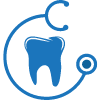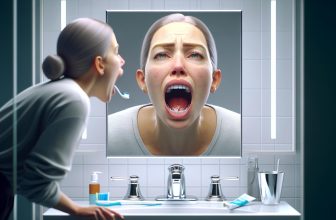
Ever bitten into a slice of pizza so hot it felt like you were auditioning for a fire-eating circus act? If you’ve ever experienced roof of mouth bleeding, you know it’s no joke. Whether it’s from a scorching bite or an unexpected injury, figuring out how to stop roof of mouth bleeding can feel like a mystery.
I’ve been there, staring at my bathroom mirror, wondering if I should call a doctor or just give up pizza forever. But don’t worry, you don’t have to choose between your favorite foods and a pain-free palate. Let’s dive into some straightforward tips to get that bleeding under control and get you back to enjoying your meals without fear.
Key Takeaways
- Common Causes: Roof of mouth bleeding can result from eating hot foods, brushing teeth with hard bristles, consuming hard or sharp foods, flossing aggressively, or using dental appliances improperly. Medical conditions like infections or mouth ulcers can also be culprits.
- Immediate First Aid: To stop bleeding, rinse with salt water or warm water, apply direct pressure using a clean cloth or gauze, and use a cold compress for 10-15 minutes to reduce swelling and slow bleeding.
- Home Treatments: Antiseptic mouthwash and over-the-counter pain relief can help manage mild cases of roof of mouth bleeding by keeping the area clean, reducing pain, and aiding in the healing process.
- Professional Help: Seek medical attention if the bleeding persists for more than 30 minutes, is unresponsive to home treatment, or is accompanied by severe pain, signs of infection, or if there’s a history of bleeding disorders.
- Prevention Tips: To prevent roof of mouth bleeding, stay hydrated, choose softer foods, avoid extremely hot foods, use a soft-bristled toothbrush, floss carefully, attend regular dental check-ups, and maintain good oral hygiene. Avoid tobacco products and consider using a mouthguard during sports or if you grind your teeth.
Common Causes of Roof of Mouth Bleeding
Eating hot food often leads to roof of mouth burns. Hot cheese on pizza is a top culprit. Accidents while brushing teeth might also cause bleeding. Using a toothbrush with hard bristles increases the risk. Injuries can occur from eating hard or sharp foods, like tortilla chips. Rarely, a medical condition like an infection or mouth ulcer may be the cause. Aggressive flossing sometimes contributes to injuries on the roof of the mouth. Finally, using dental appliances improperly can lead to cuts and sores.
Immediate First Aid Steps

If the roof of your mouth is bleeding, addressing it immediately is vital to minimize discomfort and prevent further complications. Following these steps ensures the bleeding stops quickly and effectively.
Rinse with Salt Water
Salt water acts as a natural disinfectant, promoting healing and reducing inflammation. Mix one teaspoon of salt in a cup of warm water. Swish the solution around your mouth for about 30 seconds before spitting it out. Repeat this process two to three times a day. Ensure the water is warm, not hot, to avoid additional irritation.
If there’s no salt available, use plain warm water. This method helps remove debris and bacteria from the affected area, facilitating the healing process. Although salt water is highly effective, plain warm water offers a beneficial alternative when in a pinch.
Apply Direct Pressure
Direct pressure can help control the bleeding. Use a clean cloth, piece of gauze, or even a tea bag to gently press against the bleeding area. Hold the pressure for at least 10 minutes without removing to allow a clot to form. Avoid checking the wound frequently to see if the bleeding has stopped, as this can disrupt clotting.
If the bleeding persists after initial attempts, apply pressure for another 10-minute interval. Ensuring proper application of pressure is crucial for managing immediate bleeding. Combining this with other methods can enhance effectiveness.
Use a Cold Compress
Cold compresses reduce swelling and slow bleeding by constricting blood vessels. Wrap ice cubes in a clean cloth and gently press against the roof of your mouth. Keep the compress in place for 10 to 15 minutes. The cold helps numb the area, providing temporary pain relief.
Avoid placing ice directly on the tissue to prevent frostbite. If a cold compress is not available, sipping cold water can also serve as an effective alternative. Combining cold compresses with direct pressure maximizes the chances of stopping the bleeding quickly.
These immediate actions provide effective relief from bleeding in the roof of the mouth and can help prevent further issues.
Home Remedies and OTC Treatments

Home remedies and OTC treatments can effectively manage mild roof of mouth bleeding. These methods soothe discomfort, protect against infection, and aid in the healing process.
Antiseptic Mouthwash
Using an antiseptic mouthwash helps keep the mouth clean and reduces the risk of infection. I recommend rinsing with it twice daily. Listerine or similar products are effective choices. Swish the mouthwash for at least 30 seconds to ensure it reaches all areas. This routine kills bacteria and promotes healing. In addition, it can provide mild pain relief by numbing the affected area. If the bleeding persists or worsens, it’s best to consult a healthcare professional.
Over-the-Counter Pain Relief
OTC pain relievers can reduce pain and inflammation from roof of mouth bleeding. Ibuprofen and acetaminophen are commonly used. I usually take one dose every 4-6 hours as needed, but it’s essential to follow the dosage instructions on the packaging. These medications not only alleviate pain but also lessen swelling, aiding in recovery. Aspirin should be avoided as it can increase bleeding. Always ensure you’re not allergic to the pain reliever you choose. If the pain doesn’t subside, it might be necessary to seek medical advice.
When to Seek Professional Help
If home remedies and over-the-counter options don’t improve your condition, seek professional assistance.
Persistent Bleeding
Bleeding that lasts more than 30 minutes or resumes frequently indicates a need for medical attention. If the bleeding is heavy and unresponsive to pressure or cold compress, see a doctor or dentist. When the bleeding is accompanied by severe pain, professional evaluation becomes crucial. Having a history of bleeding disorders or taking blood-thinning medication also warrants a professional’s intervention. Do not ignore prolonged or recurring bleeding, as it may signify an underlying issue.
Signs of Infection
Unusual symptoms like increased pain, swelling, or redness can signal an infection. Foul-smelling breath and pus around the bleeding site are also concerning. Fever or swollen lymph nodes in the neck are significant indicators of infection. If these symptoms accompany your mouth bleeding, it’s critical to get medical help. Recurrent symptoms of infection, despite home care, need professional evaluation. Ignoring these signs risks complications and delays proper treatment.
Tips for Prevention
Preventing roof of mouth bleeding involves taking some straightforward precautions. Hydrate regularly to keep tissues moist and prevent dryness. Dry mouth often leads to irritation and cracking, making tissues more prone to bleeding. Choose softer foods and chew slowly to avoid injuries from hard or sharp foods. Avoid consuming extremely hot foods and drinks, which can cause burns in the mouth.
Use a soft-bristled toothbrush to minimize trauma while brushing. Gentle brushing reduces the risk of injury to the delicate tissue on the roof of your mouth. When flossing, be careful not to snap the floss into your gums. Aggressive flossing can cause injury and subsequent bleeding.
Regular dental check-ups are essential. dental professionals can identify and treat issues before they lead to complications. Mouthguards provide protection if you play sports or grind your teeth at night. They form a barrier, preventing injuries that may cause bleeding.
Stop smoking or using any tobacco products. They both irritate the oral tissues and impede healing. Maintaining good oral hygiene by brushing, flossing, and using mouthwash effectively reduces the risk of infections that might cause bleeding. Following these tips helps prevent bleeding and keeps your mouth healthy.
Conclusion
Managing roof of mouth bleeding involves understanding its causes and taking immediate action. By following first aid steps like rinsing with salt water and applying pressure, you can often control the bleeding quickly. However if the issue persists it’s crucial to seek professional help. Preventive measures like staying hydrated using a soft-bristled toothbrush and maintaining good oral hygiene can go a long way in avoiding such problems. Taking these steps will not only help stop roof of mouth bleeding but also promote overall oral health.
Frequently Asked Questions
What are common causes of roof of mouth bleeding?
Common causes include burns from hot foods, injuries from brushing or eating hard foods, infections, aggressive flossing, and improper use of dental appliances.
What immediate first aid steps should I take for roof of mouth bleeding?
Rinse with salt water, apply direct pressure, and use a cold compress to reduce bleeding and swelling.
When should I seek professional help for roof of mouth bleeding?
Seek medical attention if home remedies and over-the-counter options do not improve the condition or if bleeding is severe and persistent.
How can I prevent roof of mouth bleeding?
Stay hydrated, choose softer foods, use a soft-bristled toothbrush, floss cautiously, attend regular dental check-ups, use mouthguards, quit smoking, and maintain good oral hygiene.
Is it safe to use over-the-counter treatments for roof of mouth bleeding?
Yes, over-the-counter treatments can help, but they should not replace professional medical advice if the condition does not improve or worsens.







